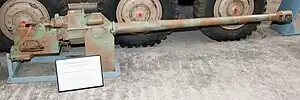Kampfwagenkanone
Kampfwagenkanone (KwK) (German, 'fighting vehicle cannon') was the designation given to any type of tank gun mounted in an armoured fighting vehicle or infantry fighting vehicle of the German-Wehrmacht until 1945. The wording was derived from the German nouns Kampfwagen (fighting vehicle) and Kanone (cannon or gun). However, the present-day designation in German speaking armed forces to this particular weapon system is Panzerkanone ('tank gun').[1]

Kampfwagenkanonen, developed in Germany, were normally derived from the construction concept of anti tank guns (Panzerabwehrkanone). Modifications were used in the anti-aircraft artillery (Flakartillerie) as well.
Examples
The following table contains examples of Kampfwagenkanonen, operated by the Wehrmacht in World War II.
| Designation (codename) |
Caliber (length) | Barrel length (in cm) | Operational platforms | |||
|---|---|---|---|---|---|---|
| Sonderkraftfahrzeug (Sd.Kfz.) | as Pak | as Flak | Others | |||
| 2 cm KwK 30 | L/55 | 110.0 | 2 cm Flak 30 | 2 cm Flak C/30 Kriegsmarine | ||
| 2 cm KwK 38 | PzKpfw II Ausf. J-L |
|
||||
| 3.7 cm KwK 36 | L/45 | 166.5 | PzKpfw III Ausf. A-F | 3.7 cm Pak 36 | ||
| 5 cm KwK 38 | L/42 | 210.0 | PzKpfw III Ausf. F-H | |||
| 5 cm KwK 39 | L/60 | 300.0 | PzKpfw III Ausf. J-M[2] | 5 cm Pak 38 | BK 5 cannon | |
| 7.5 cm KwK 37 | L/24 | 180.0 | ||||
| 7.5 cm KwK 40 | L/43 | 322.5 | PzKpfw IV Ausf. F2/G | 7.5 cm StuK 40 L/43 | ||
| L/48 | 360.0 | 7.5 cm Pak 39 L/48 | 7.5 cm StuK 40 L/48 | |||
| 7.5 cm KwK 42 | L/70 | 525.0 | 7.5 cm Pak 42 (on Jagdpanzer) | 7.5 cm Pak 42 | ||
| 8.8 cm KwK 36 | L/56 | 492.8 | Tiger I | 8.8 cm Flak 18/36/37 | ||
| 8.8 cm KwK 43 | L/71 | 624.8 | 8.8 cm Pak 43 | |||
| 12.8 cm KwK 44 | L/55 | 704.0 | 12.8 cm Pak 44 | 12.8 Pak 44 | ||
See also
References
- Panzerkanone – tank gun. Teil II/ Teil III Deutsch – Englisch. In: Bundessprachenamt (Hrsg.): Militärisches Studienglossar Englisch. Januar 2001, S. 284.
- The first 1540 tank of the Ausführung J were equipped with the shorter 5 cm KwK 38.